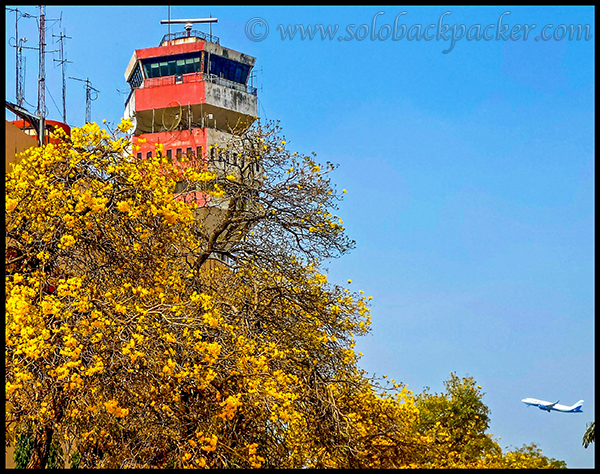Air Traffic Control is a mysterious world for many, an unknown territory of many speculations. Millions of people fly daily from one destination to another, but only few of them are aware of inside stories of the Air Traffic Control Units. Most of them might have never heard about the Air Traffic Control at all. Air Traffic Control is an important pillar of the aviation industry worldwide. Whenever you travel on your travel plans, vacations, board meetings, business deals, family reunions etc, you come across numerous airlines staff, ground crew and flight crew, but there is a high probability that you never cross the path of an air traffic controller. And, even if you cross, you never notice them. The Air Traffic Controllers are the person hidden in the background who keep the world running. The underrated worldwide community of the controllers perform a fantastic job round the clock to keep everyone safe in the sky. We, as the controllers, have our own puzzled dynamic world.
When people come to know that I am an Air Traffic Controller, they have two impressions in the mind most of the time. Their first impression is that I wear that reflective jacket and signal the aircraft from the ground with baton, beacon or flag in my hands. 🙂 No, I don’t do that. They are not the Air Traffic Controllers, they are known as the Marshallers.
The second impression is that it’s a highly stressful job. Yes, it is. But not always. I do enjoy it as much as you enjoy your job without any stress. Read on this post to clear your doubt about the Air Traffic Control.
The first introduction of an Air Traffic Control Unit comes from the Control Towers, that can be considered as the face of Air Traffic Control at every single airport. At bigger airports, these control towers are normally the highest as well as the most beautiful structure in the airport area, thus easily catching the attraction of the travellers. An interesting fact is that the ATC services are not provided only from the control towers at the airport, but also from the other facilities situated miles away from the airport. There are different units of the air traffic control centres, that direct a flight from one place to another. These units may situated at a single place or may situated miles apart from each other.

Being an Air Traffic Controller, let me give you some idea about our world of Air Traffic Control. ATC is basically a service provided by the controllers, who direct the pilot of an aircraft on the ground as well as in the air. The Controllers are based on the ground and provide these services to the pilot over their respective communication channels. The primary task of an Air Traffic Control Unit is to prevent collision between the aircraft in the air and on the ground. We are also supposed to organise and expedite the flow of air traffic. Sometimes, the pilot may not need an active Air Traffic Control Service, but only need some support or information from the controllers.
Air Traffic Controllers: The controllers, the unsung heroes of the aviation industry, are the highly trained professionals working in the control towers and in the other air traffic control units. In the modern and highly-advanced technological world, we act as the eyes of the pilots. Modern airliners have sophisticated aviation instruments on board to help the pilots in the sky, but all the pilots trust on the air traffic controllers to reach the destinations safely. An equipment can help a pilot to make good decisions in the emergency situations, but only a human controller can judge the gravity of that situation by hearing the voice of a pilot. We are trained enough to handle many nerve-racking situations with an incredible peace of mind. Most of the time, we are supposed to be assertive and firm-decision makers.
However, we are pretty much like the other normal people. It’s a really demanding job, most of the time mentally, but we are always supposed to keep our calm. After the formal education in India, there were many skills we have to master from the scratch, because before induction in this job, most of us have no idea about this profession. We learn the standard aviation language (phraseology), aviation rules, procedures, airspaces, communications with aircraft, meteorological phenomenon, air navigation etc to perform our job efficiently.
How is The Life of an ATC? Before becoming an active controller (we call it rated controller for that particular unit), we go through a rigorous training to learn a hell lot of things. We should not only know about the standard operating procedures in the normal scenarios, but should also know that what to do in the emergencies, what to do in the hijack situation, what to do in the bomb threat, how to deal with the VVIP movements and a lot of other procedures. We have to learn about aircraft types, their performances, airport limitations, runway characteristics, airspace constrains etc.
Once we become a rated controller, we are the boss of our own communication channel. ATC is completely a team game, but when we take over a channel to handle the live traffic, we are the only responsible person for that channel with respect to our right and wrong decisions. Nobody can interfere with our decisions unless there is a known critical safety threat. At a busy airport, we have a lot, mind it, a lot of goosebumps everyday. There is thrill, there is speed, and there is a sense of adventure. Do you need anything else in a job?
It’s mostly a male world, where the women controllers are catching very fast. Majority of us are still young. The ATC units are mostly vibrant, fun-filled and dynamic in the nature. There are time when you can sense the stress in this job, but most of the time we enjoy this game very much. We do joke, party, play games and spend quality time with each other as the co-workers. It’s a very challenging and demanding, but immensely rewarding career. The brilliant thing about this job is that we almost never took it home with us. When we took our headset off, our job is done.
But it’s not a rosy picture always. The drawback is that we work round the clock in 24×7 facilities. We work during nights, weekends, festivals, holidays throughout the career, so there is no particular social life. The shift pattern keeps rotating in a cycle of Morning Duty, Afternoon Duty and then Night Duty. After night duty, there is 48 hours OFF before the next morning shift. Sometimes, we are supposed to perform additional duties also during our OFF days. The pattern of this shift cycle vary from one airport to another.
We do miss enjoying some moments with our families and the friends. We don’t have a New Year Day, Deepawali, Dussehera etc, every day is just a normal traffic day for us. Sometimes it looks like a routine affair, and you do the same thing everyday, but still, no two days are equal for an air traffic controller.There are the moments, when we have a rude voice on the other end of the communication channel, because sometimes the pilots behave like the kids, who wish to play with their favourite toys in their own way, but the traffic conditions don’t allow that. There are the arguments, heated exchanges, complaints but at the end, we both respect each other very much. Some organisational issues are also there when we do feel that we are underpaid, we don’t get appreciation for our efforts, there is no particular growth path after few years in this job due to the lack of more exposures and many other issues, but that happens in every other job also. It is only us, who can make our life pleasant by maintaining a proper work-life balance.
How Stressful is it? Depends. As an Air Traffic Controller, we enjoy our profession very much, doesn’t matter how much stress we handle everyday. We are trained enough to handle any emergency situation or the constant pressure of this job. It’s actually not that much stressful as people think, but then again, people handle stress differently. Also, it depends on the traffic scenario, working conditions, weather conditions and other infrastructural issues.
So, why is this stress? I am unable to paint that picture of stressful conditions here. When we talk about air traffic, we actually talk about hundreds of lives and billions of dollars. So much is there on the stake with incredibly thin margin of the error. Just for an idea, consider some facts..A flight speed is normally 480 Knots ( 860 kms per hour) in route control, where separation is 10 NM (18 KM ) on radar from one aircraft to other. In approach control, the separation between two flights are only 3 NM (5.4 Km) and the speed is normally 250 Knots. While landing, an aircraft’s normal approach speed is 160 Knots. If you do all the calculations of speed, distance and time, you will learn that in the normal scenario, the controllers have to make their decisions within few seconds for the correct sequence of actions and that too without a margin of error, but we all are the humans. We do make errors, but then we are supposed to rectify that error within the seconds.
We all know that safety is paramount, but still, there is a constant conflict between the speed and the safety. A slight disruption due to the weather conditions or any operational issues has cascading effect for the hours. We are not the robots and never work like a machine, we are like other human beings with our own personality traits but still, we have to be above average 100 % of the time, else hundreds of human lives will be under threat within the seconds. There are no bypassing in this game and we can not escape away from a situation, so we have to deal with that somehow. This is where the training plays a crucial role. It’s not a physically demanding job, but there are times when we reach home and are mentally exhausted.
How to Become an ATC in India? In most parts of the world, Air Traffic Controllers are recruited by the Air Navigation Service Providers (ANSPs) from the respective countries. In India, the Air Traffic Controllers are recruited by the Airports Authority of India (AAI), an organisation responsible for providing the air navigation services across the country. AAI conducts a written exam followed by an interview and a voice test during the selection process.
The candidates possessing regular full time Bachelor’s degree (3 years) in Science (B.Sc) with Physics and Mathematics from recognised university with minimum 60% marks or full time regular Bachelor’s degree in Engineering/ Technology (B.E./B.Tech) in the disciplines of Electronics / Telecommunications / Information Technology with minimum 60% marks are eligible to apply online for the written examination. Few people get short-listed during the written exam for the personal interview and a voice test. If you clear these exams, you are inducted as a Junior Executive (Air Traffic Control/Air Traffic Management) in AAI, following a medical examination.
After induction in the AAI, a Junior Executive goes through a rigorous training schedule for 6 months at one of the training centres established in Allahabad, Gondia and Hyderabad. Later, on successful completion of the training, they may get posted at any of the airports in India.
After first posting at the airport, they again undergone through a live training under supervision of qualified ATC instructors to get the real exposure of the job. In case of the major airports like Delhi and Mumbai, the live training can be continued upto one year. Following successful completion of the live training and some exams, they are allowed to handle a live traffic channel without supervision, it means that the controller is rated for that particular unit. That is just the beginning of an exciting career in the air traffic control. Few years under the line in this job, an individual is supposed to enhance his/her skills through various trainings in the different ATC units, however, the thrill of the job started with the independent handling of first live channel.
Can I Spend My Lifetime in This Job? why not? I love what I do as an Air Traffic Controller. It’s a perfect adventure package for me, paying me good amount of money to live a quality life and stay happy. I can certainly spend rest of my working life as an Air Traffic Controller. I don’t think that there is another job of this kind for me. It’s not because I don’t have another option, but because there is nothing like this mysterious world of Air Traffic Control 🙂 . Being an Air Traffic Controller is a sense of pride and I am proud to be.
At The End: Don’t judge our profession with the Bollywood movie Dhamal. Watch some Hollywood movies e.g. Pushing Tin, Ground Control, United 93, Final Descent etc to enjoy the adventures of Air Traffic Control. 🙂








very much impressed and i am also going on an UG course in aviation management. i loved ur blog respect to the ATC’s . JAI HIND .
Thank you. All the best for your course.
Can a woman start a career in this field after having kids?
Of course. There are lot of women controllers in India, who are managing her home as well as the airspace in a perfectly smooth manner. Isn’t it a super fun?
Very interesting read avanish.. Thanks for introducing us to the world of atc
Thank you. Glad that you like it. 🙂
Is there any promotion with post of ATC in India? I mean which is next post you will get after promoting from ATC?
An ATC only remains an ATC throughout the career. It’s a specialized job. So, whether you are a Junior Executive (starting of the career) or a DGM , you only control the air traffic. As you grow higher on the ladder and with age, people tend to lean towards the administrative works rather than active controlling on the live channels. So you are still an ATC at higher levels, but now the nature of job is to manage an ATC facility in the capacity of the top management team.
Thank you very much
Thank you for giving a sneak peak into your work life. I want more, do a follow up post give us examples 😀 Take off the names but give us examples. I remember this incident even today https://en.wikipedia.org/wiki/%C3%9Cberlingen_mid-air_collision
I will try to write some more posts on the working of Air Traffic Control Units. Thank you for liking this post. 🙂